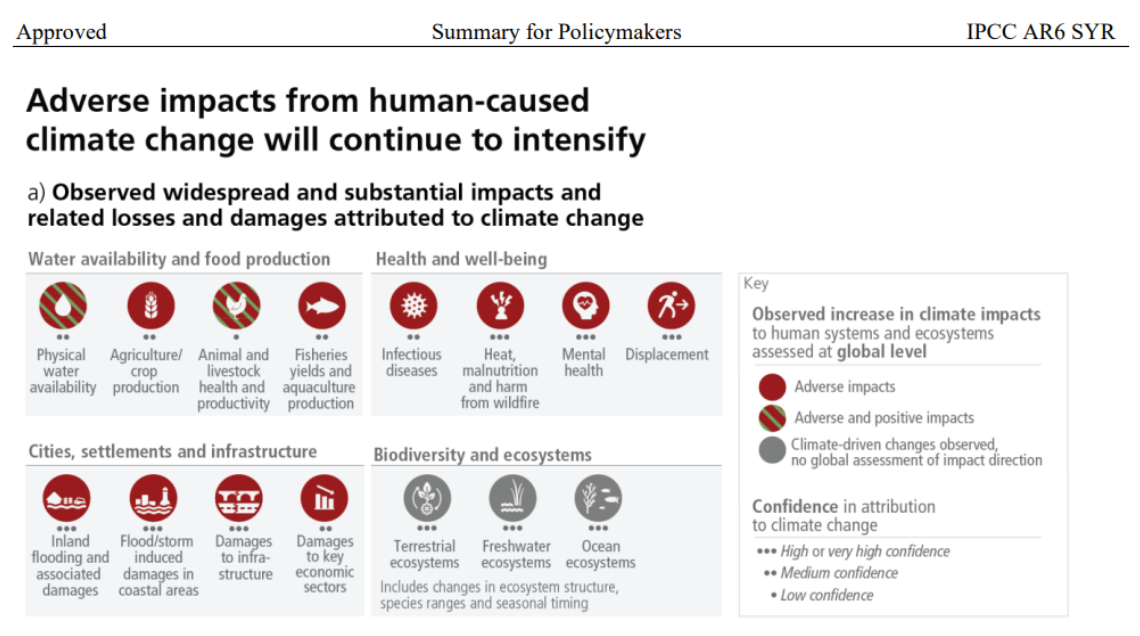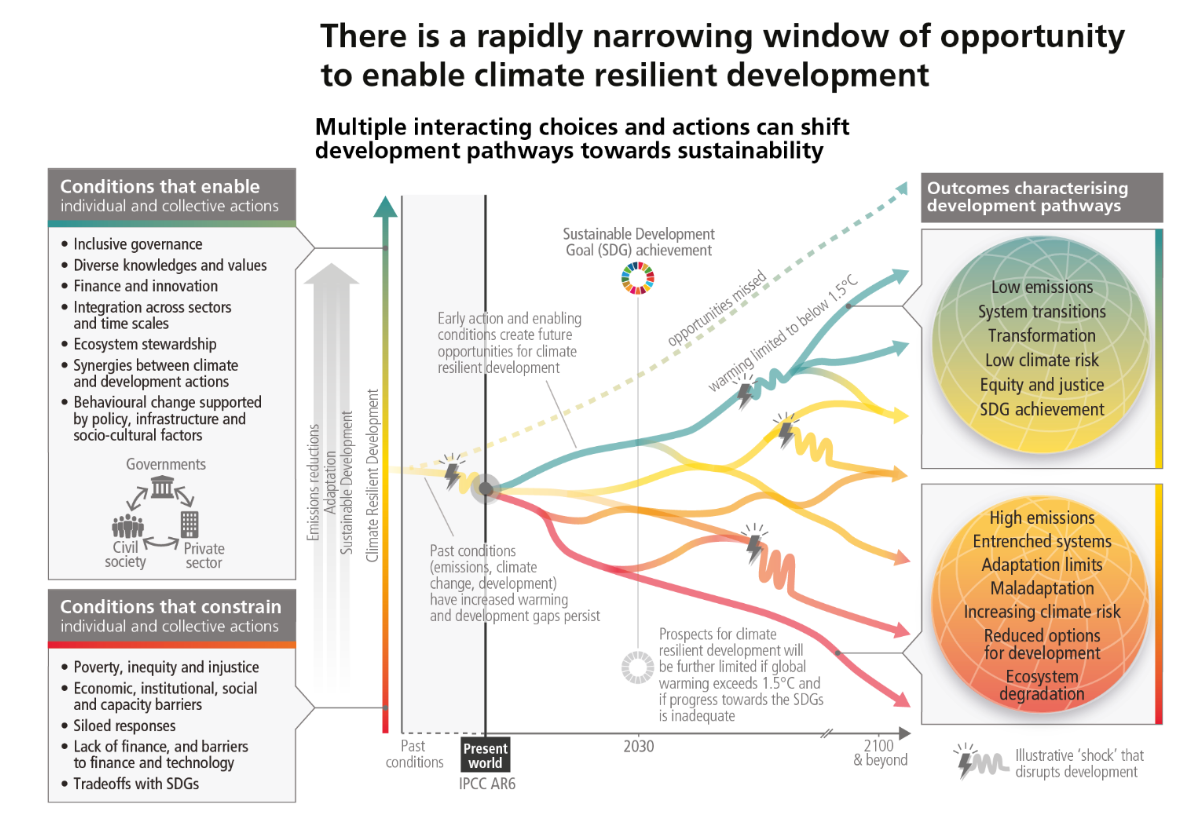Why the IPCC’s Latest Report Should Spur a Rush to Adapt


· 6 min read
When many people think about climate adaptation, their first reaction is something akin to, "That's a worthy goal, but let's focus on mitigation. Adaptation and resilience are our backup plan for 2050 if we come up a little bit short. But we're resourceful and we'll hit those UN climate targets. Now let's focus on the urgent stuff."
Following the release on Monday, March 20 by the Intergovernmental Panel on Climate Change (IPCC) of the Synthesis Report of its Sixth Assessment Cycle, the focal point of media attention has been the ‘last warning’ to cut emissions in order to meet the 1.5˚C global warming stretch goal of the Paris Agreement. This common reaction is understandable and true to form for policymakers and journalists but misses the main points.

What are the main points? Many argue, including the IPCC’s own press release, that we need to focus on the “narrowing window” for action to stay within 1.5˚C (2.7˚F) warming. We must keep hope alive and focus on cutting emissions steeply and fast. Of course, this is essential – but, in the clear-eyed words of The New Yorker’s Elizabeth Kolbert, “[T]o imagine at this point that the latest warning from the I.P.C.C. will spur action, when so many previous ones have failed to, requires not just hope but, it would seem, something close to delusion.”
The real main points, for those willing to swallow bitter pills, are as follows. First, the IPCC summary report’s first pages state bluntly,
“Human-caused climate change is already affecting many weather and climate extremes in every region across the globe. This has led to widespread adverse impacts and related losses and damages to nature and people. Vulnerable communities who have historically contributed the least to current climate change are disproportionately affected.”
In short, the impacts are here, they are serious, and they are unrelenting, particularly for the world’s poor and disenfranchised.
Second, human society is not adequately adapting.
“Despite progress, adaptation gaps exist, and will continue to grow at current rates of implementation. Hard and soft limits to adaptation have been reached in some ecosystems and regions.”
Third, the warming is nowhere near stopping.
“Continued greenhouse gas emissions will lead to increasing global warming, with the best estimate of reaching 1.5°C in the near term in considered scenarios and modelled pathways.”
By ‘near term’, the IPCC means within ten years, not the world of our great-grandchildren.
And yet, breathless media coverage still manages to downplay or ignore the need for urgent adaptation. Remarkably – but not out of step with coverage in The New York Times and The Wall Street Journal – The Guardian’s article on the latest IPCC report, highlighting the eight most urgent actions to take on climate change, includes none focused on adaptation. Instead, there is the suggestion that the 1.5˚C threshold could be preserved with urgent action. And The Washington Post, in the first sentence of its article on the report, falsely suggests that Earth might not cross the 1.5˚C threshold within 10 years if “nations drastically transform their economies and immediately transition away from fossil fuels.”
The flaws here are manifold. To start, we face rapid warming today, pushing us up to and past the 1.5˚C threshold in the coming years – regardless of what achievements in urgent decarbonization we achieve (the 1.5˚C accomplishment of urgent decarbonization would be achieved by the year 2100, after an “overshoot”). The inescapable result will be myriad devastating climate shocks, not to mention the unpredictable social, political, economic, and financial fallout thereof. Consequently, climate adaptation and resilience are about as urgent as it gets on the planetary scale – as urgent and existential as the mitigation challenge to rein in future emissions.
Anything short of mass mobilization to adapt to inevitable near- and middle-term climate impacts is tantamount to willful denial. A well-regarded study released last month concluded that 1.5˚C is now out of reach. A new AI-driven analysis published in January largely concurred. We are already seeing practically unmanageable catastrophic impacts such as unprecedented heat waves and drought in Europe and the Pacific Northwest, epic floods in Pakistan and Germany, terrifyingly powerful storms in the Caribbean and Southeast Asia, and immense wildfires across the American West, Southern Europe, Siberia, and Australia.
These impacts are striking at today’s level of only about 1.2˚C of warming, which is, of course, merely a global average.
In many places, such as the Arctic, the warming is already substantially greater, and coming at us faster than ever: the IPCC indicates we are on a path to exceeding 1.5˚C by the early 2030s. On top of that, we will likely exceed that threshold temporarily as early as this year thanks to the warming cycle of the emerging El Niño. The cyclical impacts are already here, and getting stronger and weirder than ever. We are likewise at risk of triggering a series of irreversible tipping points in our natural systems, such as glacier and permafrost melt, sea level rise, and ecosystem collapse, requiring adaptation and resilience at a much greater scale and more urgent pace than envisioned by many casual observers.

What can countries, communities, and organizations do to protect themselves? The first order of business is to take a comprehensive and sober look at the near-term climate threats and assess their risk exposures under a series of plausible scenarios, focused on the near term as well as the long term. These scenarios should consider not only chronic physical risks such as rising temperatures, precipitation change, and sea level rise on the time scales of 2050 and beyond, as is common in the climate policy discourse, but also potential near-term extreme weather events, ecological tipping points, and the impacts of complex interactions of social, political, and economic systems, which are often neglected in climate projections and models. The IPCC AR6 Synthesis Report and other associated reports are a great place to begin to consider likely climate-driven adverse effects. There is a robust literature and rapidly-expanding corpus of practice for effective adaptation and resilience. However, investment in adaptation and resilience is lagging badly, while the capacity for adaptation is limited and requires dramatic improvement. Similarly, risk management and preparedness for climate-related hazards remain inadequate.
A major psychological and cultural barrier to climate adaptation is the misconception that accepting adaptation means giving in to pessimism or declaring defeat. This couldn’t be further from the truth: proactive adaptation is about optimizing for human thriving in the face of limited resources and environmental constraints, just as mankind has done with aplomb and ingenuity since time immemorial.
So what are we waiting for? We don’t need to give up on reducing emissions to pick up the gauntlet for adaptation. We are long past the luxury of choosing one or the other. It’s time to get cracking.
illuminem Voices is a democratic space presenting the thoughts and opinions of leading Sustainability & Energy writers, their opinions do not necessarily represent those of illuminem.
Steven W. Pearce

Adaptation · Mitigation
illuminem briefings

Corporate Governance · Adaptation
illuminem briefings

Sustainable Finance · ESG
Devex

Sustainable Finance · Adaptation
Sustainable Views

Sustainable Finance · Adaptation
Politico

Climate Change · Agriculture